Since DoorDash was founded in 2013, Dashers have leveraged our platform to earn for as few or as many hours as they choose to meet their goals – whether that’s saving for a special moment, making up for shortfalls from a full-time job, or something else. Traditional employment alone works for many, but millions of people want more opportunities and flexibility to earn extra income how and when they want. DoorDash helps solve this unmet need. For the more than 13 million people who have dashed since 2013, being able to earn at the touch of a button has provided over $35 billion in earnings through the platform.
What brings Dashers to the platform? We took a dive into our Dasher data to find out how the average Dasher uses our platform and how their work patterns differ from traditional employment. We then looked at highly active Dashers (those who spend more than 10 hours a week on delivery) to see how they uniquely use the platform. We found that in both cases - the average and the highly active Dasher - flexibility is critical.
The average Dasher
Dashers choose DoorDash over other opportunities for the flexibility dashing provides, the benefits to their well-being, and the ease with which they can start and stop work
From a recent U.S. Dasher Survey, we know that 84% of Dashers dash around their other responsibilities. This includes Dashers who have a full- or part-time job, are self-employed, are students, are retired, or are full-time caregivers or stay-at-home parents. These Dashers come to DoorDash for a multitude of needs that aren’t typically met through traditional employment, especially not all together:

The average Dasher spends less than 4 hours per week on delivery and 72% of Dashers average even less than that
Dashers spend very few hours per week on delivery while juggling anything from a full-time job to classes to childcare. One Dasher's goals may look completely different from the Dasher standing next to them at the same restaurant. In fact, there's very little average about the way the "average" Dasher uses the platform.
Looking at how many hours every Dasher averaged per week, we see that only a few highly active Dashers (the top 12%) average more than 10 hours per week on delivery, while almost three quarters (72%) were below the 4-hour mark. In fact, the vast majority of Dashers aren’t averaging anywhere close to the hours typically associated with even part-time employment (about 20 hours) and 96% of all Dashers averaged less than 20 hours per week on delivery:
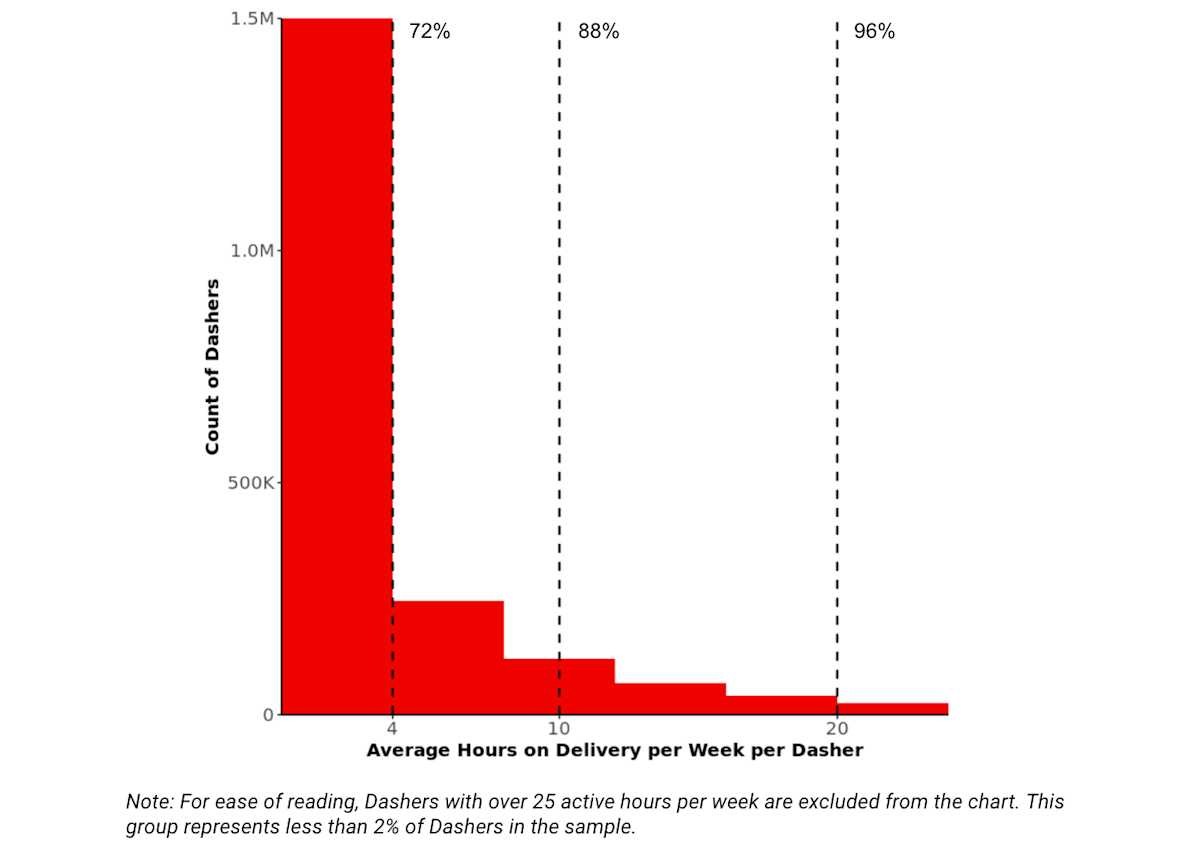
Why are these numbers so low? Because Dashers can come and go as they please and deliver for as long (or as little) as they like. No two weeks look the same when it comes to how much they dash or whether they dash at all. They often take weeks off across a quarter or take multi-week breaks from dashing. Almost 1 in 5 Dashers (19%) dashed in only a single week over the quarter and nearly 3 out of 4 (73%) did not dash in 4 or more weeks across the quarter. Additionally, many Dashers take weeks off before returning in the same quarter. Over a third (37%) of Dashers took a consecutive 2-week break before dashing again in the same quarter and 14% took a consecutive 4-week break before returning in the same quarter.
An average of 4 hours per week doesn't always mean 4 hours every week
This data shows that many Dashers have something in common: they value the ability to start and stop as they please and take breaks for as long as they like – breaks employees don’t have the flexibility to take. Moreover, each Dasher uses the control they have over their work to tailor their dashing hours to fit their unique needs and commitments. If we select ten Dashers at random with the same average number of hours in the quarter (about 4 hours on delivery per week), there is no pattern as to how one Dasher uses the platform in comparison to another Dasher. Some Dashers consistently spend a few hours each week on delivery, while others have spikes in some weeks followed by weeks with no activity.
Activity per week per Dasher with their age and location
All of these Dashers averaged 4 hours on delivery per week in the quarter but their activity week-by-week is vastly different.
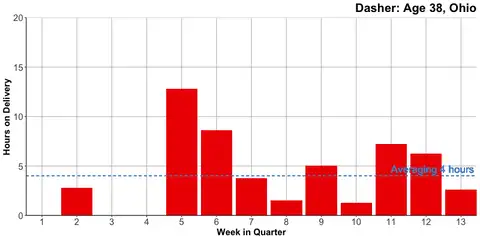
Dashers are doing many things while on the app: 60% combined dashing with other activities
So far, the data we’ve seen examines the time that Dashers spend delivering. But what about the time spent online between deliveries? During that time, Dashers are eligible to receive and review delivery offers, but they can reject offers that don’t suit their needs. Since many Dashers have other responsibilities, they can and do easily incorporate dashing into their daily routine in a way that suits them best. 60% of Dashers report that they combined dashing with other activities like picking up groceries or doing other errands (31%), commuting or traveling (27%), or picking up/dropping off their kids (12%).
Even when we account for on-app time, the vast majority of Dashers are averaging very few hours on the app per week. In fact, 62% of Dashers spent less than 4 hours per week on the app in total compared to the 72% we saw above who spent less than 4 hours per week on delivery.
Highly active Dashers
Our data suggests that for the average Dasher, flexibility is critical. But does this hold true for Dashers who spend a lot of time on the platform? Through survey and internal data below, we find that highly active Dashers are even more likely to value and fully leverage the flexibility of dashing.
Highly active Dashers aren't using the platform like employees and 90% prefer to remain as independent contractors
In any given quarter, around 90% of Dashers deliver less than 10 hours per week and most deliveries are completed by Dashers who deliver for relatively few hours. In fact, over three-quarters of all deliveries were completed by Dashers who delivered for less than 20 hours per week (which is less than the average hours of a part-time employee). But what about the small number of Dashers who spend more time on the platform? Let’s consider all Dashers who averaged more than 10 hours per week to be “highly active.” Are these Dashers fundamentally different from the average Dasher and, given that they dash longer-than-average hours, do they want to be employees? When we ask them this question, we see that highly active Dashers overwhelmingly prefer to remain as independent contractors (90%), slightly above the share of all Dashers (87%). When we examine this cohort, we find that even among the highly active Dashers there’s a lot of variability in dashing behavior – and dashing is still just a supplemental source of income for them.
Looking at activity for highly active Dashers, we see that their hours, days, and weeks of dashing are quite variable. Highly active Dashers tell us that they want control of their circumstances, value the freedom to not be tied to a job they don’t like, and don’t have regular or set days for dashing. In fact, they value those features even more than average Dashers who work fewer hours.
These Dashers may be just over the top 10th percentile for hours spent on delivery per week, but they’re still only spending a fraction of their time on the platform. When they’re not dashing, almost 70% of highly active Dashers have other income or responsibilities that they dash around. This includes almost half who have a full- or part-time job or are self-employed, and another 21% who are students, stay-at-home caregivers, or retired. In short, highly active Dashers spend more hours dashing, but still value the control to turn the app on and off when and how it works around their life commitments. This explains why 86% of highly active Dashers say that even if they received the benefits and other protections afforded to employees, they would not continue to dash if they couldn't choose the days or times they worked.
Highly active now doesn't mean highly active always: About one third of these Dashers are less active in the previous or next quarter
Highly active Dashers are a fluid group. In the chart below, the middle red line represents all highly active Dashers in the quarter. The flows to the left show how they dashed in the previous quarter and the flows to the right show how they dashed in the following quarter. We find that 29% of the current quarter’s highly active Dashers were not highly active or not active at all in the previous quarter (the nodes to the left) and 39% were no longer highly active or not active at all the following quarter (the nodes to the right).
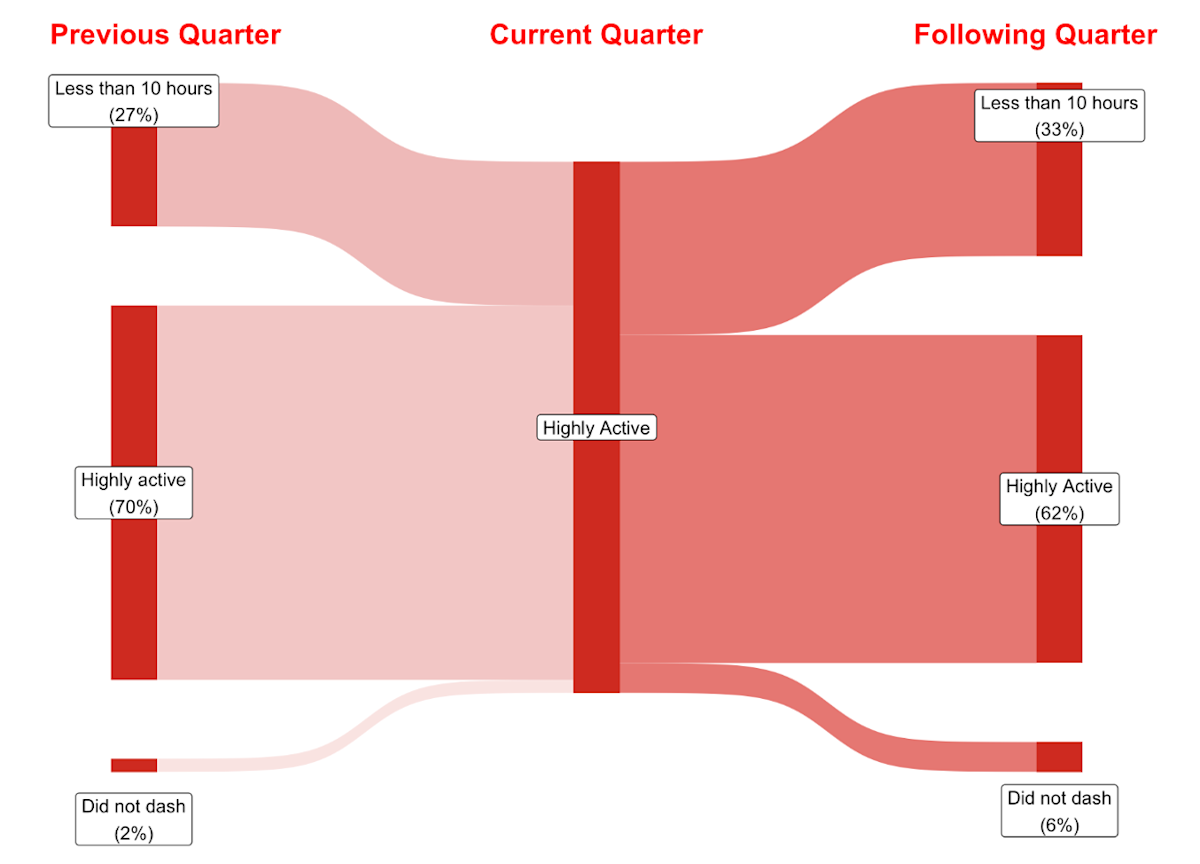
Highly active Dashers choose to deliver because the flexibility gives them more time with their family and more time for themselves
In our 2023 national Dasher survey, we found that highly active Dashers are more likely to say that one of the main reasons they dash is because they enjoy it (46% vs 32% for less active Dashers) or because dashing is better for their overall mental health/well-being (27% vs 19% for less active Dashers). This cohort of Dashers was also more likely to report that spending quality time with family or caring for loved ones (68% vs 56%) is an important aspect of flexible hours.
Only a small share (5%) of highly active Dashers said that one of the main reasons they dash is because they aren’t able to get other kinds of work - consistent with the 4% for all Dashers in our survey. Two-thirds of highly active Dashers (67%) say that dashing gives them the freedom to leave a job they don’t like (compared to 51% of all Dashers) and 9 out of 10 highly active Dashers surveyed agree that dashing makes them feel more in control of their circumstances.
Highly active doesn’t mean typical 9-5 hours: 56% say they have no regular days or times for dashing
In fact, this is reflected in our dashing data. On average, highly active Dashers deliver to suit their needs, just like any other Dashers. If we take the most active week of each highly active Dasher and compare it with their least active week, we see that on average they dash 24 more hours in the most-active week than in their least active week, which suggests they have high week-to-week variability.
Illustration: A range of 24 hours between their most and least active weeks could look like this
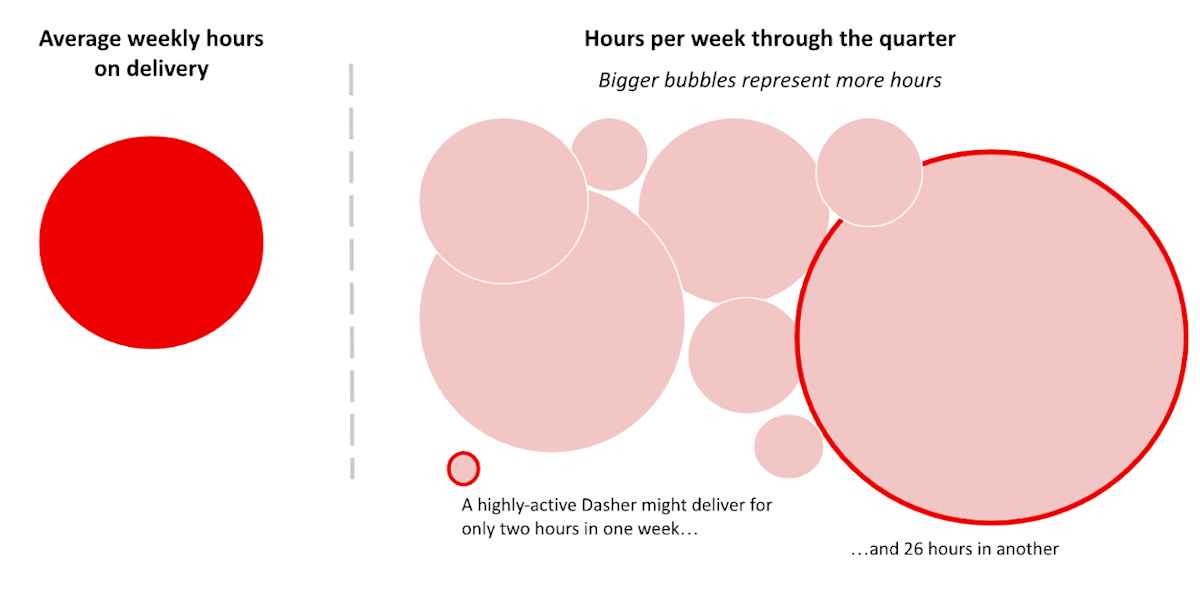
Take, for example, the chart below depicting the schedule of a randomly chosen Dasher who averaged 13 hours per week through the quarter. The red areas indicate times of the day across the quarter when the Dasher chose to be on the app and available to see delivery offers (not just when they were on a delivery). Darker red areas mean that the Dasher was more frequently on the app during those times and days of the week across the quarter compared to the lighter areas.
Highly active Dasher: Activity across all 13 weeks of the quarter
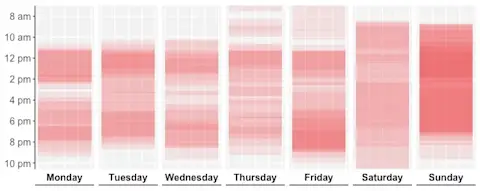
From the chart, we see that this Dasher often comes online on Sundays and Friday nights, and then occasionally comes online during lunch and dinner times on other days. This chart looks across the quarter and gives us insight into which days/hours in the day are overall preferable to this Dasher but to see the week-to-week variability we have to go one level lower.
When we break out each of the thirteen weeks, we see that there’s a lot more variability than we initially saw. Start times vary between 8am and 4pm and many days have long breaks in between time on the app. In two of the weeks they chose not to dash at all, while in others they chose to dash only one or two days.
Highly active Dasher: Break out of the chart above by week
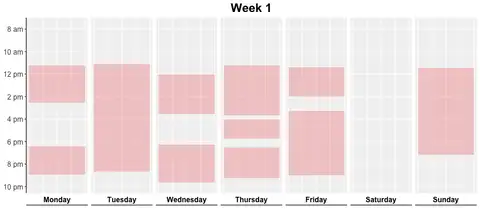
Protecting the flexibility to earn & our vision for the future of independent work
Highly active Dashers, like all other Dashers, are using dashing to meet a need that they can’t meet through traditional employment: the ability to decide when, how much and whether to work. We’re steadfastly committed to strengthening this independent work that brings millions of people to our platform and protecting the flexibility that we know Dashers overwhelmingly value, while guaranteeing new protections and benefits to help meet their unique needs.
Our Vision for the Future of Work would empower Dashers — especially highly active Dashers — to access new benefits, without having to trade in their flexibility and independence.
This analysis uses internal data of Dashers active in 2022 Q4. Limited to Dashers who have dashed at least once in the 6 months preceding the start of the quarter and at least once in the 13 complete weeks in the quarter.



